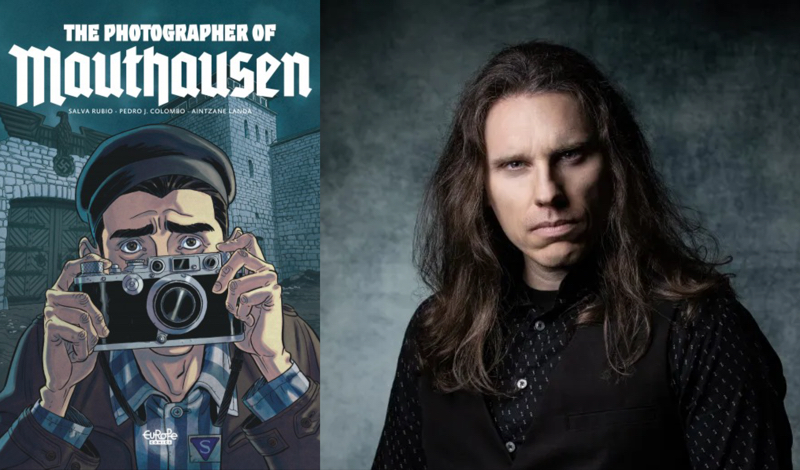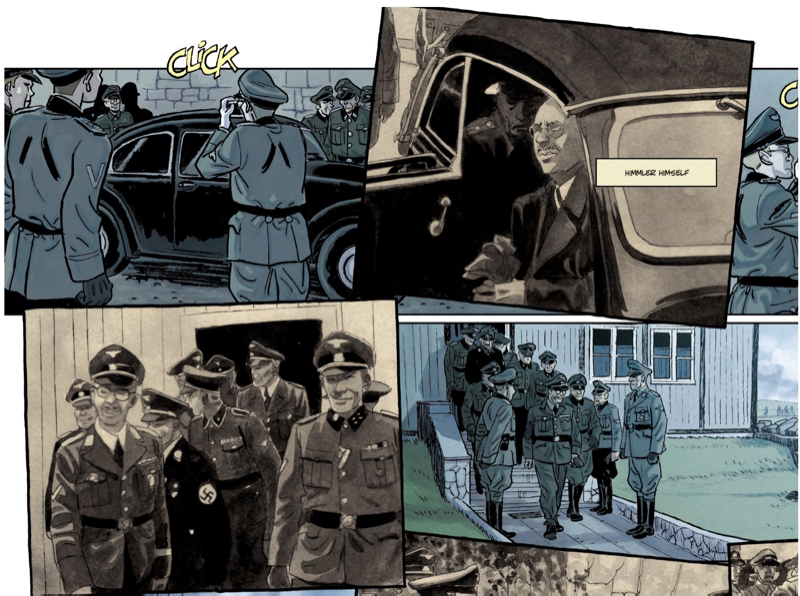Most online accounts of Ernst Kaltenbrunner and Albert Speer mention that they were convicted at the Nuremberg trials but few accounts mention the testimony and evidence provided by Francisco Boix that enabled those convictions. Nor do they mention the bravery and sacrifices of the people involved in preserving and delivering that evidence to the outside world.
The Photographer of Mauthausen by Salva Rubio (writer), Pedro J Colombo (illustrator) and Aintzane Landa (colourist) tells the story of Boix, a Spanish photographer and veteran of the Spanish Civil War. Following his part in the civil war, Boix was exiled to France and joined the French army before being captured by the Germans. The Photographer of Mauthausen starts with Boix's arrival at Mauthausen in 1941.
Boix starts off his internment as a translator but soon finds a position in the photography lab. Somehow, inexplicably, SS-Hauptscharführer Paul Ricken takes a liking to to Boix and recruits him as assistant to his macabre photography project. In this role, Boix is exposed to the many atrocities being committed at Mauthausen (in addition to the ones he had already witnessed).
Boix realises initially that this evidence needs to be preserved and several prisoners get involved in making this happen. However, as news reaches camp of an impending Russian victory, Boix realises that he needs to get proof of the atrocities to people on the outside of the camp.
Boix was successful and both his testimony and the photographic evidence proved that Nazis such as Kaltenbrunner and Speer were not only aware of what was happening at Mauthausen but they were complicit in the atrocities too.
The value of The Photographer of Mauthausen is in the questions that it raises about justice and remembrance. At the time of the Nuremberg trials, the photos were used to obtain convictions but Boix expresses frustration on page in the graphic novel about why people weren't more concerned about what happened at Mauthausen and the atrocities committed.
The Photographer of Mauthausen is an excellent graphic novel that tells, in an accessible format, an important story in the annals of Holocaust history while serving as an educational source on both Nazi atrocities and the trials following the war.
I give The Photographer of Mauthausen a superb five out of five stars. The graphic novel is extremely well illustrated and written and recommended for those interested in history, graphic novels and the Holocaust.
★★★★★



3 comments
Thanks - new to me. I went looking for a publisher and an ISBN and came across this useful web page with background from Europe Comics: https://www.europecomics.com/photographer-mauthausen-snapshot-harrowing-past/ The authors seem to have taken some small imaginative liberties.
It seems to be buyable online at https://www.europecomics.com/album/the-photographer-of-mauthausen/.
There's a Spanish film made in 2018 that's available on Netflix.
I'd never stopped to consider the quarrying that was the brutal activity at the core of Mauthausen. The section of the Europe Comics text by Ralf Lechner gives the context:
"Several days after the Third Reich annexed Austria in March 1938, the new authorities announced their intention to build a concentration camp there — a “privilege,” according to August Eigruber, the Gauleiter (regional leader) of Upper Austria. In expectation of a marked increase in prisoners, the SS, who managed the camps, planned to set up supplemental detention centers. At the same time, the SS leadership considered launching themselves in the manufacture of construction materials. The SS found in this plan a justification for the expansion of concentration camps as well as an exclusive source of manual labor. In April 1938, the SS established the Deutsche Erd- und Steinwerke GmbH (DESt) in order to manage the production of construction materials using forced labor from concentration camps. The SS then began to search for a location where they could build a concentration camp that would permit them to achieve their economic goals.
In the end, Mauthausen and Gusen were chosen because of their nearby granite quarries. The SS-run company would deliver construction materials for the prestigious buildings and monuments of the Third Reich thanks to the labor done at the quarries by prisoners of the concentration camps."
Not long ago I read "The Boy Who Followed His Father Into Auschwitz" by Jeremy Dronfield which is a fascinating / horrific account of life in the work details and includes a section on evacuation from Auschwitz / Monowitz to Mauthausen.
https://www.theguardian.com/books/2019/jan/21/boy-who-followed-father-into-auschwitz-jeremy-dronfield-review
The post was a very interesting starting point that's taken me in all directions. The film aroused a lot of controversy, regarding the narrative's treatment of historical "truths" and its characterisation of the protagonists, but also the political undercurrents of the narrative, opening wounds going back to the Spanish Civil War - divisions on the Republican side and Franco's suppression of the truth about the deportations from France.
An informative summary at US Holocaust Memorial Museum at https://collections.ushmm.org/search/catalog/pa5632 (expand "About This Photograph")
I don't have Netflix but I watched the film online at Videa yesterday in semi-audible Spanish and German, with Hungarian subtitles, (Spanish-Hungarian co-production). I wasn't too keen on it - there's a Spanish style of scene-setting and delivery that I find counter-productive to appreciating the content. However, the development of the narrative covers a number of key sceness / episodes. Then at the very end, leading into the credits, a sequence of the real photographic images that I found particularly moving because of the insight the film's account of the background provided.
There's more at https://www.finestresullarte.info/en/works-and-artists/the-music-that-accompanied-the-horror-of-mauthausen-and-the-photographer-who-saved-it which explains the length of time devoted to the sequence in the film showing the hanging of Hans Bonarewitz, the carpenter. Along with the mention in the USHMM text this webpage is useful in explaining the importance of the relationship with young boy who is the link to the Poschacher Kommando and Anna Pointner who played a crucial role in ensuring that Ricken's negatives were saved from destruction and able to be produced at the Mauthausen trial.
Thanks for opening up that viewhole into Mauthausen - I've learned a lot as a result.
Finally, going off on a Rwandan tangent: at our local library I recently came across "If the Hills Ask for Your Blood" by David Belton who reported the genocide for the BBC. The account of his investigation of what happened to Fr Vjedko Curic, a Bosnian Croat priest who helped save a lot of lives during the killings, isn't reassuring as far as Rwanda's safety as a place of outsourced asylum application processing (albeit published in 2015).
Good article. I certainly appreciate this site. Keep writing!
Post a Comment